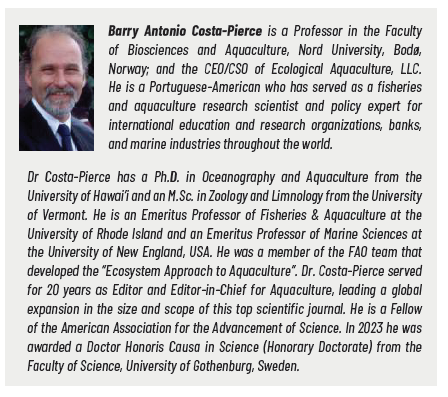Article II 3/2024: RESTORATIVE AQUACULTURE FOR PEOPLE, PROFIT AND PLANET

Bivalve and lower trophic level aquaculture have led the way, as there exist important examples where user conflicts were resolved due not only to technological advances but also to a growing consensus that aquaculture can “fit in” in an environmentally and socially responsible manner in many marine coastal environments, the majority of which are already crowded with existing users. Adoption of restorative aquaculture by aquaculture industries and coastal communities can provide a strong scientific basis for a new social contract for aquaculture by contributing to regional sustainable development planning, advancing new policies and investments to accelerate aquatic food production; and by using the many methods of ecological aquaculture for environmental restoration to replace hearsay, junk science, and misinformed advocacy.
Setting the stage for restorative aquaculture
For all its advances over the past 50 years, global aquaculture remains concentrated in Asia, which accounts for about 90% of the production from this sector. The region farms the largest number and variety of aquaculture species and most of the world’s aquafarmers are Asian1.
China dominates Asian production (65%); Egypt dominates Africa (73%); Chile dominates the Americas (34%); and Norway dominates Europe (45%). The largest ecosystem on Earth, Oceania, has a tiny amount of global aquaculture production (0.2%) (Table 1). Only Norway, Chile and Egypt produce more than 1 million tonnes/year; but these production successes outside of Asia remain regionally-concentrated (tilapias in the upper Nile, salmon in southernmost Chile); as well as limited in the diversity of species farmed and systems used (salmonids in net cages, tilapias in ponds).
TABLE 1. Animal aquaculture production, by region and leading producers (million MT). Source: FAO 2020

For all its advances over the past 50 years, global aquaculture remains concentrated in Asia, which accounts for about 90% of the production from this sector. The region farms the largest number and variety of aquaculture species and most of the world’s aquafarmers are Asian1.
China dominates Asian production (65%); Egypt dominates Africa (73%); Chile dominates the Americas (34%); and Norway dominates Europe (45%). The largest ecosystem on Earth, Oceania, has a tiny amount of global aquaculture production (0.2%) (Table 1). Only Norway, Chile and Egypt produce more than 1 million tonnes/year; but these production successes outside of Asia remain regionally-concentrated (tilapias in the upper Nile, salmon in southernmost Chile); as well as limited in the diversity of species farmed and systems used (salmonids in net cages, tilapias in ponds).
“the degraded state of many aquatic ecosystems combined with public concerns about adding any new sources of aquatic pollution to already over-burdened ecosystems will require aquaculture to develop ecosystem approaches and sustainable operating procedures and to articulate a sustainable, ecological pedagogy. In the 21st century, aquaculture developers will need to spend as much time on designing ecological approaches to aquaculture development that clearly exhibit stewardship of the environment, as they do on technological advances coming to the field. Clear, unambiguous linkages between aquaculture and the environment must be created and fostered, and the complementary roles of aquaculture in contributing to environmental sustainability, rehabilitation and enhancement must be developed and clearly articulated to a highly concerned, increasingly educated and involved public.”
Development of restorative aquaculture
While the use of the adjective “restorative” attached to “aquaculture” is a recent development, it follows directly from, and is aligned with, the theories, principles, and practices of many areas of ecological restoration (Figure 1). All were developed by environmental scientists having the overall goal of reversing the major structural and functional damages to Earth/ocean systems due to industrialization and urbanization post-WWII to the 1970s (Box 1).
Figure 1. Scope for restoration and ability to recover naturally (artificial habitats are in italics)
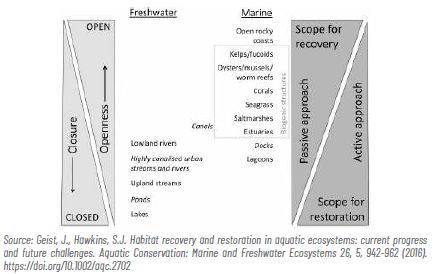
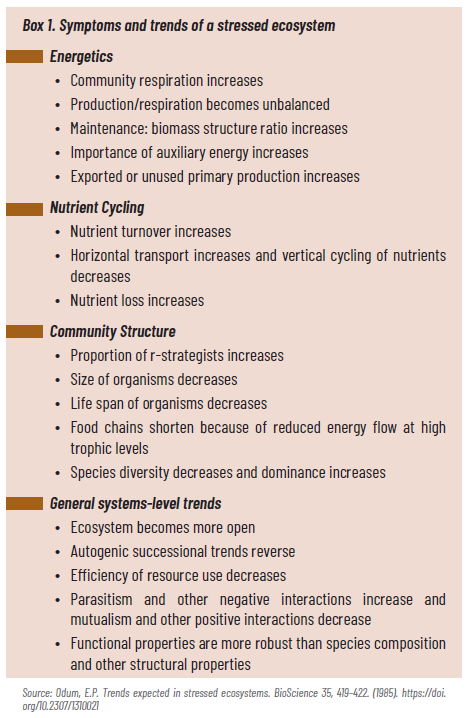
3) HLPE. Sustainable fisheries and aquaculture for food security and nutrition. (2014) A Report by the High Level Panel of Experts on Food Security and Nutrition of the Committee on World Food Security. 4 Costa-Pierce, B.A., Bridger, C.J. The role of marine aquaculture facilities as habitats and ecosystems, (2002), 105-144. In: R. Stickney & J. McVey (Eds.) Responsible Marine Aquaculture. CABI Publishing Co., Wallingford, U.K.
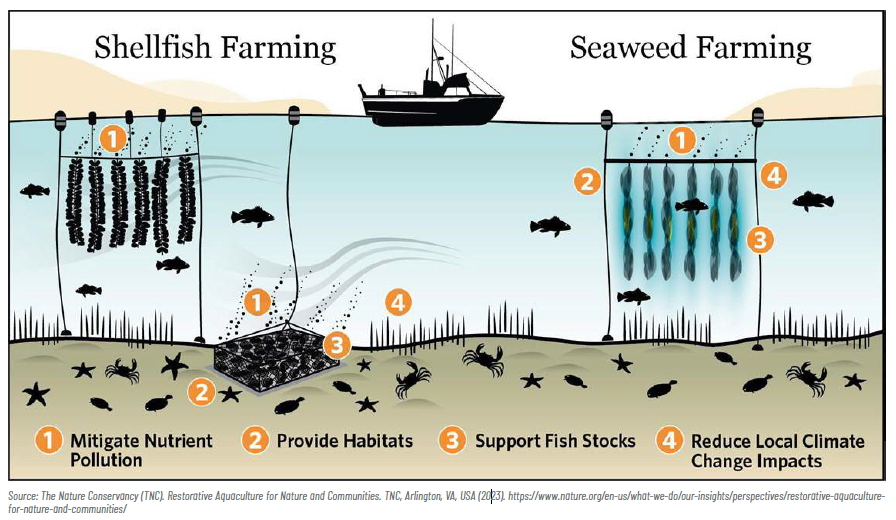
“Marine aquaculture of lower trophic level aquatic species (mostly aquatic invertebrates), such as bivalves, urchins, sea cucumbers, and seaweed aquaculture have the ability to improve water quality, serve as buffers to coastal erosion, ameliorate nutrient pollution, provide essential habitats for other species, and transform carbon, nitrogen, and phosphorus cycles. Such production systems mirror agro-ecosystems, aiming at broad preservation of ecosystem functionality.”
Ecosystems goods and services provided by lower trophic level restorative aquaculture of shellfish and seaweeds
Restorative aquaculture can be a cornerstone that changes the dynamic of aquaculture development in its new geographies as it is a critical part of all of the SDGs, sustainable rural development, and enhanced environmental sustainability. But restorative aquaculture is a new rubric, with a new community of practice which doesn’t necessarily align with “traditional” aquaculture communities. Development of restorative aquaculture has been facilitated by the new entry of a wider diversity of actors and organizations also concerned with aquaculture’s social-ecological impacts (diversity, inclusion, indigenous) beyond its technological progress. This is especially so in aquaculture’s new geographies outside of its well-established modern and historical home in Asia.
The leading organizations in the funding and development of restorative aquaculture to date are not traditional industry or academic organizations, but large international conservation NGOs such as The Nature Conservancy (TNC) and the International Union for the Conservation of Nature (IUCN). IUCN has incorporated aquaculture into its portfolio of “Nature-based Solutions”6&7; meanwhile, TNC has developed the “Global Principles of Restorative Aquaculture”8&9 which define restorative aquaculture as:“…occurring when commercial or subsistence aquaculture provides direct ecological benefits to the environment, with the potential to generate net positive environmental outcomes.”
6) Le Gouvello, R., Brugere, C., Simard, F. Aquaculture and Nature-based Solutions. Identifying Synergies Between Sustainable Development of Coastal Communities, Aquaculture, and Marine and Coastal Conservation. IUCN, Gland, Switzerland (2022). https://doi:10.2305/IUCN.CH.2022.02.en
7) Le Gouvello, R., Cohen-Shacham, E., Herr, D. et al. The IUCN global standard for Nature- based Solutions™ as a tool for enhancing the sustainable development of marine aquaculture. Front. Mar. Sci. 10:1162487 (2023). https://doi.org/10.3389/fmars.2023.1146637
8) The Nature Conservancy (TNC). Global Principles of Restorative Aquaculture. TNC, Arlington, VA, USA (2021). https://www.nature.org/content/dam/tnc/nature/en/documents/TNC_PrinciplesofRe torativeAqua culture.pdf
9) Alleway, H. K., Waters, T. J., Brummett, R. et al. Global principles for restorative aquaculture to foster aquaculture practices that benefit the environment. Cons. Sci. Practice, e12982 (2023). https://doi.org/10.1111/csp2.12982
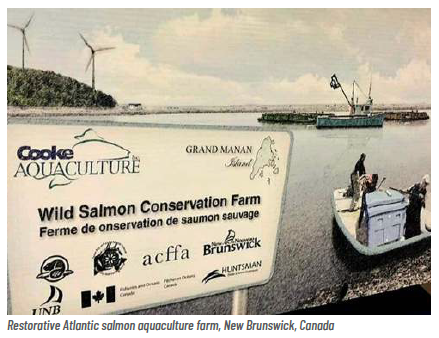
Examples of restorative aquaculture
Aquaculture today is a transdisciplinary science which can be defined as investigations of “wicked problems” that need creative solutions; reliance on stakeholder involvement; and engaged, socially responsible science11.
Included in TNC’s foundation document, the “Global Principles for Restorative Aquaculture”, are three examples and roadmaps for restorative aquaculture at a significant scale: (i) impacts of filter-feeding carps on lake water quality in China; (ii) the emergent seaweed industry in Belize; and (iii) the large oyster restorative aquaculture initiative called SOAR (Supporting Oyster Aquaculture and Restoration). There are many others being recognized and developed; ten examples are given in Table 2. All include innovative partnerships and multiple opportunities for the aquaculture industry, for applied research, for communications professionals, and for communities. As can be seen, restorative aquaculture is not limited to animals but also includes “freshwater and marine agronomy”, a sophisticated form of higher- and lower-plant aquaculture which produces not only commodities for sale, but also assimilates nutrients and creates and restores disturbed natural habitats worldwide. Tidal wetland, mangrove forest and seagrass restoration are all forms of restorative aquaculture that create, enhance, and maintain productive ecosystems and habitats in a long-term, sustainable manner.
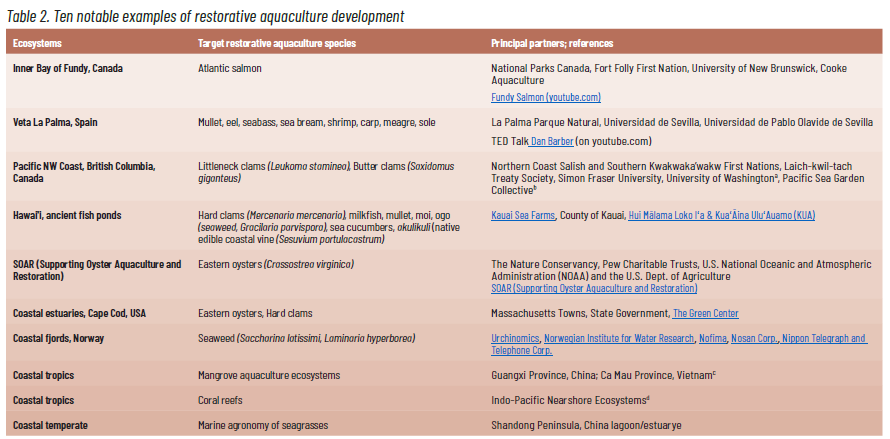
b) Pacific Sea Garden Collective. Sea Gardens Across the Pacific: Reawakening Ancestral Mariculture Innovations. Version 1. Washington Sea Grant at the University of Washington (2022). https://www.seagardens.net
c) Romañach, S., DeAngelis, D.L., Koh, H.L. et al. Conservation and restoration of mangroves: Global status, perspectives, and prognosis. Ocean & Coastal Mgt. 154, 72-82 (2018) https://doi.org/10.1016/j.ocecoaman.2018.01.009
d) Zhang, D., Fang, C., Liu, J. et al. An effective seed protection method for planting Zostera marina (eelgrass) seeds: Implications for their large-scale restoration. Mar. Poll. Bull. 95, 89-99 (2015). https://doi.org/10.1016/j.marpol.2004.09.001
e) Pomeroy, R.S., Parks, J.E., Balboa, C.M. Farming the reef: is aquaculture a solution for reducing fishing pressure on coral reefs? Mar. Policy 30, 111-130 (2006). https://doi.org/10.1016/j.marpol.2004.09.001
A new social construct for aquaculture expansion
As one of the world’s most widely traded foods, globalization has affected seafood communities locally by accentuating production places, regions and exports. All direct consumption and developments remain, however, in one way or another, regionally- and locally-contextualized. Development of community-based, hyper-local restorative aquaculture ecosystems serve to demonstrate new aquatic food production systems with shortened value chains that assist in the evolution of the “culture of aquaculture”. Community-based restorative aquaculture systems can ameliorate nutrient pollution and climate change and reclaim and help preserve the Earth’s remaining biodiversity while contributing significantly to local economic and cultural development. With the proper documentation - and the development of new narratives – the development of cooperative, transdisciplinary restorative aquaculture ecosystems can yield greater returns for a community’s “return on investment” (ROI).
Two hyper-local examples in the USA illustrate the potential for new conceptual frameworks for ROIs. Louisiana has lost millions of hectares of coastal wetlands but is home to about 68 000 ha of red swamp crayfish (Procambrus clarkii) aquaculture/ rice wetlands. From mid-autumn to mid-spring, aquafarmers cultivate crayfish, then in summer they grow rice. This crayfish/rice aquaculture ecosystem is an essential habitat for colonial water birds. It can be argued that the crayfish aquaculture wetlands have allowed a stunning recovery of birds, many of which are considered endangered and threatened. The Lake Martin rookery east of Lafayette, Louisiana is an example. This rookery is surrounded by more than 13 000 ha of aquaculture crayfish wetlands which support robust nesting populations of egrets, herons, ibis, and spoonbills, all of which have rebounded dramatically. Bird predation causes economic losses to crayfish farmers, but bird tourism, recreation, and sport hunting incomes are worth millions of additional dollars a year to rural communities (see also Veta La Palma, Spain, in Table 2).
Another very important example of restorative aquaculture has been developing over the last 10–15 years in towns along the estuary-rich coast of Cape Cod, Massachusetts, USA. Towns in this region urgently need to control water pollution that has led to an increased number and severity of harmful algal blooms in coastal estuaries and freshwater ponds, principally due to accelerating inputs of nitrogen and phosphorus to aquatic ecosystems in the warmer months of the year. The Massachusetts Estuaries Project (MEP) was created in partnership with the University of Massachusetts to conduct detailed scientific reviews and modelling studies12 that determine the total daily maximum load (TMDL) necessary to support healthy estuarine ecosystems. This is followed by actions of towns who develop watershed plans to remove nitrogen loads to achieve the target TMDLs.
Traditionally, water quality restoration goals have been met almost universally by a focus on capital-intensive development of sewer systems (this very public debate continues everywhere). Falmouth, a coastal town on Cape Cod which has about 30 000 residents (around 90 000 in summer), is seeking a new solution. The town has 14 diverse estuaries. In 2002, Falmouth was cited for violations of the US Clean Water Act due largely to nitrogen pollution, especially nitrate from septic systems which leached nitrogen into groundwater and then into estuaries; in addition, one highly-impacted estuary receives 70% of the effluents from a wastewater treatment plant. Nitrogen loadings are very high; total loadings were estimated for some estuaries as high as 30.2 tonnes of nitrogen per year. Over the past years, Falmouth has included shellfish aquaculture and residential urine diversion in its nitrogen-removal strategies, to complement the traditional sewer approach.
Incorporating shellfish aquaculture and urine diversion into plans has demonstrated how restorative aquaculture and individual homeowners, via urine diversion, could contribute to more comprehensive nutrient remediation and environmental restoration. Urine diversion is the concept of diverting urine from wastewater to manage nitrogen, since 80% of the nitrogen in wastewater is from urine, but urine is only about 1% of its volume (about 120 gallons [454 L/person/year])13&14. Thus, managing urine is a very efficient and cost-effective method of nitrogen removal from the environment. Using these two more affordable methods of nitrogen reduction means less reliance on the traditional demands by governments for increased taxes to fund ever-increasing and very costly capital investments in sewering.
Innovative restorative aquaculture is in part of the plans in Falmouth, which has zoned areas for both commercial and recreational shellfish farming for nitrogen removal to ameliorate damaging coastal pollution. Nutrient credits that will accrue to the town, that the State would give for the amount of nitrogen the shellfish harvests remove each year, are an active part of the on-going discussions. Any town resident can harvest a limit of one bushel of oysters per harvest trip (about 10–15 kg) during the permitted season (late Fall to early Spring). Commercial shellfish farmers are contracted by the town and pay a USD 20 000 access fee for 0.5 acres (0.2 ha) of coastal bay. Shellfish farmers are obligated to grow a maximum biomass on the lease. In 2023, shellfish farmers harvested 1.43 million oysters from just 1.5 acres (0.6 ha). The town has determined that nitrogen nutrient credits per oyster harvested would be 0.28 g N/ oyster. In 2023, it was estimated that a total of 400 kg of nitrogen was removed from the 1.5 acres (0.6 ha) of oysters. This removal could offset about USD 3 million in costs for additional sewer infrastructure. The oysters harvested produced an estimated commercial gross revenue of USD 350 000 to USD 700 000. This restorative aquaculture scheme is so successful that the area is expected to increase ten-fold in 2024.
Planners have calculated a hypothetical case to determine if combining urine diversion and oyster aquaculture together could eliminate the need for sewering in one watershed. This example watershed has about 4 500 homes. At a 4.5 kg N discharge to groundwater per house/year, the total nitrogen to be removed would be 20 250 kg. Assuming that 75% of the urine can be captured by homeowners (3.4 kg N), urine diversion could remove about 15 300 kg N/year. If 1.5 acres (0.6 ha) of oysters captured 400 kg N, only 12.4 acres (5 ha) of additional shellfish aquaculture could remove all the remaining 4 950 kg of nitrogen.
13) Wald, C. How recycling urine could help save the World. Nature 602, 202-206 (2022). https://mahb.stanford.edu/wp-content/uploads/2022/03/d41586-022-00338-6.pdf
14) Maingay, H., Barnhart, E. Putting urine to work for us. Falmouth Enterprise, February 2, 5 (2024) https://www.capenews.net/falmouth/columns/putting-urine-to-work-for-us/article_b967ca90-5a8d-57de-94cc-7eef9655d947.html
The future of restorative aquaculture
For the future growth of restorative aquaculture globally and locally, there will be needs for: (i) aquaculture industry adoption and investment; (ii) transparent, third-party requirements of Monitoring, Reporting and Verification (MRV); (iii) alignment into the planning, development, and monitoring of freshwater and marine protected areas (MPAs); (iv) significant engagement of indigenous nations and fostering their leadership; and (v) expansion and development into rewilding initiatives.
There are reviews and roadmaps now available for industry and communities to consider; for example, in restorative shellfish aquaculture15. Important commercial examples now exist such as Offshore Shellfish Ltd. and Plymouth University (UK) which have provided the scientific basis for mussel aquaculture development in energetic ocean sites via an array of opportunities and funds that have been obtained to support a diversity of targeted applied aquaculture and environmental studies.
The standard for determining what is “restorative aquaculture” is the clear emphasis on the “net positive” for the environment. As such, all operations claiming to meet this high standard should be required to undergo MRV to ensure that the standard is met. This will be a challenge but could also be an exciting opportunity for aquaculture operations to partner on an equal and strategic basis, and to avoid any exploitation and tokenism too often present in the past. Whether this will evolve into some sort of formal or informal certification regime remains an open question.
Planning and development of restorative aquaculture in communityconserved biodiversity hotspots such as aquaculture in marine protected areas (MPAs), as led by the IUCN, are very important future opportunities for aquaculture growth16.
Indigenous aquaculture communities are ancestors of all global aquaculture practitioners alive today. Indigenous knowledge systems of aquaculture are part of not only their birthrights but of all humanity17. An estimated 80% of the world’s remaining biodiversity is in the indigenous nations worldwide. Leadership in restorative aquaculture by indigenous communities can not only reclaim their past wisdom but also advance community-based restorative aquaculture locally and globally. Restorative aquaculture development by traditional knowledge-keepers in indigenous nations can help ameliorate the combined climate and biodiversity crises, while re-orienting economies to more sustainable approaches. Alignment of restorative aquaculture with the IUCN Global Indigenous Network for Aquaculture (GINA) is a tremendous opportunity18.
16) IUCN. Aquaculture and Marine Protected Areas. Report (2017) IUCN, Gland, Switzerland https://portals.iucn.org/library/node/46692
17) Costa-Pierce, B.A. The anthropology of aquaculture. Front. Sustain. Food Syst. 6:843743 (2022). https://doi.org/10.3389/fsufs.2022.843743
18) Global Indigenous Network for Aquaculture. International Union for the Conservation of Nature (IUCN) Declaration at the World Conservation Congress (2020). https://www.iucncongress2020.org/motion/
Other references
• Costa-Pierce, B.A. Ocean food systems and hybrid seafood production: Transdisciplinary case studies of cod, eels, salmon and lobster. Sustainable Development Research (2023) 5, 31-43.https://doi.org/10.30560/sdr.v5n1p31
• Costa-Pierce, B.A. Sustainable ecological aquaculture systems: the need for a new social contract for aquaculture development. Marine Technology Soc. Jor. (2010) 44, 1-25. https://doi.org/10.4031/MTSJ.44.3.3
• Dinerstein, E., Vynne, C., Sala, E. et al. A global deal for Nature: Guiding principles, milestones, and targets. Science Advances 5, eaaw2869 (2023). https://doi.org/10.1126/sciadv.aaw2869
• Edwards, P. Aquaculture environment interactions: Past, present and likely future trends. (2015). Aquaculture, 447, 2-14.https://doi.org/10.1016/j.aquaculture.2015.02.001
• The Nature Conservancy (TNC). Restorative Aquaculture for Nature and Communities. TNC, Arlington, VA, USA (2023). https://www.nature.org/en-us/what-we-do/our-insights/perspectives/restorative-aquaculture-for-nature-and-communities/
